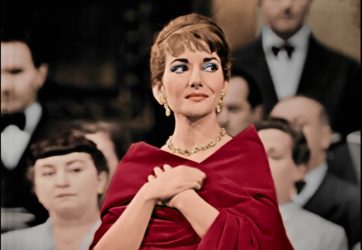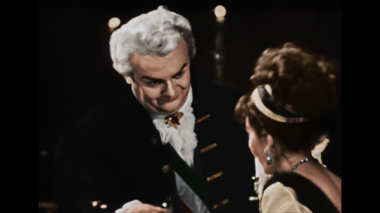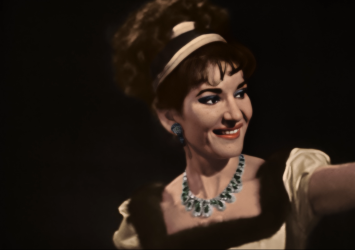 France CALLAS – PARIS, 1958: Maria Callas (soprano), featured soloists, Chorus and Orchestra of the Théâtre National de l’Opéra de Paris / Georges Sébastian (conductor). Filmed for ORTF by Roger Benamou on 19.12.1958 and released in cinemas in the UK and Ireland on 11 & 12.11.2023. (JPr)
France CALLAS – PARIS, 1958: Maria Callas (soprano), featured soloists, Chorus and Orchestra of the Théâtre National de l’Opéra de Paris / Georges Sébastian (conductor). Filmed for ORTF by Roger Benamou on 19.12.1958 and released in cinemas in the UK and Ireland on 11 & 12.11.2023. (JPr)

Programme:
Bellini’s Norma – ‘Sediziose voci … Casta Diva’ with Jacques Mars (Oroveso)
Verdi’s Il trovatore – ‘D’amor sull’ali rosee’ … Miserere’ with Albert Lance (Manrico)
Rossini – Il barbiere di Siviglia – ‘Una voce poco fa’
Puccini – Tosca Act II with Tito Gobbi (Scarpia), Albert Lance (Cavaradossi), Louis Rialland (Spoletto), Jean-Pierre Hurteau (Sciarrone)
‘Last night, they were immediately full of warmth. There was a kind of understanding between me and the audience, naturally I was afraid, because there was too much publicity, too much of everything, the French wanted too much, they wanted everything, and I wanted to give them more than everything! And … that’s a bit difficult.’ (Maria Callas speaking after the event.)
What you see is a film about Maria Meneghini Callas’s first appearance in Paris which is topped and tailed by her arrival at the Gare de Lyon with a voiceover (in French but there are subtitles) saying ‘She has arrived but who knows if she’ll sing. There’s a good chance she’ll sing.’ Considered ‘the voice of the twentieth century’ it is the 100th anniversary of Callas’s birth and she was almost 35 in 1958 and at the height of her career; though obviously some notoriety preceded her which no doubt is well-documented elsewhere. This was Callas’s first appearance on the stage of the Palais Garnier in all its Second Empire splendour. Everybody who was everybody was there for what was described as a Legion d’Honneur gala; in passing I certainly recognised such disparate attendees as the Duke and Duchess of Windsor and Brigitte Bardot escorted by Sacha Distel.
What you will see at the cinema is of huge importance, though perhaps not for the soprano’s diehard fans who might have experienced this concert in previous versions released over the years, but for someone like me who doesn’t listen to many (any?) recordings to get some idea what all the fuss was about. You can read how it is available now ‘for the first time entirely in colour and in 4K Ultra HD – meticulously restored from the recently discovered original 16mm reels and a newly discovered sound source.’ I certainly don’t want to put off anybody interested from going to their local cinema for CALLAS – PARIS, 1958 but – in my opinion – it certainly hasn’t had the restoration this would suggest in 2023, it is more likely they have made the best they can with what they have got.
The film is narrated throughout with the focus on Callas herself and if you are interested in who she sings with – apart from the chorus of course – it will merely pass you by during the closing credits. I was impressed by Callas’s regal bearing and striking features and, in looks, she brought to mind the iconic bust of Nefertiti in Berlin’s Egyptian Museum. Much apparently was made at the time of the red velvet dress Callas wears in the first half of the gala and she glitters with expensive jewellery. It is staged on a sumptuous set with a chequerboard floor which looks to be from the first act of La traviata. Callas sings from the front of the stage initially surrounded by the chorus with the men in evening dress and women in blouses and black skirts.
She begins with Norma’s ‘Sediziose voci’ (‘Seditious voices’) followed by the cavatina ‘Casta diva’ (a pray for peace following a virtuosic scene-setting flute obbligato) and then the cabaletta. Callas first sang the druid high priestess Norma in 1948 and her performance is a little melodramatic but throughout there is expression, warmth, rich chest voice, full control over effortlessly long-spun lines, as well as evidence of supreme technical agility. This certainly held good for the deeply affecting extract from Verdi’s Il trovatore we then heard on the now darkened stage as ‘D’amor sull’ali rosee’ was followed by ‘Miserere’. For the latter she is joined by the offstage chorus and Australian – though with French citizenship – tenor Albert Lance, a name totally new to me, as Manrico whom Callas’s Leonora is trying to save. (Callas first sang Leonora in 1950.)
Concluding the first half is Rosina’s showpiece aria from Il barbiere di Siviglia when she promises whoever marries her that ‘I am docile, I am respectful, I am obedient … but if they don’t follow my will, I can be a viper’ which I suspect applied to Callas herself! She is more playful here and there are seamless flights of coloratura without any suggestion that Callas would ever have been a natural Rossinian. Indeed, Rosina was a role she only sang once on stage in 1956.

If this wasn’t enough to attract you the highlight of CALLAS – PARIS, 1958 is seeing and hearing her as Tosca, perhaps her signature role which Callas first sang at 18 in 1942. We are treated to the entire second act with Callas alongside the Scarpia of her generation, Tito Gobbi. The set was detailed and sumptuous and shows us a well-furnished room in an Italian palazzo (it may even be Versailles of course) at the turn of the nineteenth century with Scarpia and his men frock-coated and bewigged and Tosca in an exquisite fur-trimmed, gold(-looking) gown, matching shawl and with even more dazzling jewellery. Gobbi is someone I encountered later in life at a masterclass but never saw perform live in an opera and his suave tones makes his character’s predatory instincts all the more chilling. There is a hint of Orson Welles about Gobbi’s Scarpia and he has Oscar-winning eyebrows! The Italian baritone’s naturalistic acting seems before its time though Albert Lance, now as Cavaradossi, is more ‘old school’ though his tenor voice is robust and always interesting.

Looking every centimetre the diva Callas sings ‘Vissi d’arte’ – as Tosca rails against her fate – from the back of the stage before coming to the front and ending on her knees in prayer. Innately she is poised and elegant whilst a certain fragility and vulnerability – perhaps more Callas than Tosca – makes her ‘Vissi d’arte’ all the more heart-wrenching.
Hungarian-born, French conductor Georges Sébastian and his Orchestra of the Théâtre National de l’Opéra de Paris is difficult to assess given the film’s sound quality whilst clearly supporting Callas admirably with some understated orchestral accompaniment.
For oh so many reasons, CALLAS – PARIS, 1958 is recommended and should not be missed by opera lovers of whatever vintage.
Jim Pritchard
CALLAS – PARIS, 1958
CLICK HERE for all global release dates
CLICK HERE for the trailer
Director and Producer – Tom Volf
Production and Restoration – Samuel Francois-Steininger
International Distribution – Piece of Magic Entertainment
Runtime – 90 minutes

It was amazing
An excellent film. Colour adds another dimension to the singing and acting. Callas did sing and record another Rossini role; Il Turco in Italia together with Il barbiere di Siviglia.
The 1957 recording is considered one of the best versions. Not to forget Armida; staged at Florence in 1952.
It was wonderful.